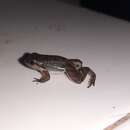pms
nòm ant ël fil


Colostethus inguinalis is a species of frog in the family Dendrobatidae. It is endemic to northwestern and northcentral Colombia.[1][2][3] Its vernacular name is common rocket frog,[2] although this name can also refer to Colostethus panamansis that until 2004 was considered a junior synonym of Colostethus inguinalis.[4] Much of the older literature on Colostethus inguinalis is actually about Colostethus panamansis.[5]
Adult males measure 22–27 mm (0.87–1.06 in) and adult females 23–30 mm (0.91–1.18 in) in snout–vent length. The tympanum is well-defined and pale anteriorly. An oblique lateral pale line extends halfway from groin to the eye- Adult males with solid black throat, with the black pigmentation usually extending onto the chest and the anterior belly; adult females have white (unpigmented) or faintly pigmented gray or brown chest. The toes are moderately webbed. Adult males have swollen third finger.[5]
Colostethus inguinalis is a diurnal species of humid lowland forests at elevations of 0–400 m (0–1,312 ft)[1] or 300–800 m (980–2,620 ft) above sea level,[3] depending on the source. It often occurs along rocky sections of forest streams. The eggs are laid in leaf litter; the adults carry the tadpoles to streams.[1]
It is an abundant species, but deforestation for agricultural development, logging, human settlement, illegal crops, and pollution resulting from the spraying of illegal crops is a major threat; it is suspected that the overall population is declining. This species can be found in a number of protected areas.[1]
Colostethus inguinalis is a species of frog in the family Dendrobatidae. It is endemic to northwestern and northcentral Colombia. Its vernacular name is common rocket frog, although this name can also refer to Colostethus panamansis that until 2004 was considered a junior synonym of Colostethus inguinalis. Much of the older literature on Colostethus inguinalis is actually about Colostethus panamansis.
Colostethus inguinalis[1][2][3] es una especie de anfibio anuro de la familia Dendrobatidae.
Esta especie es endémica de Colombia. Habita en los departamentos de Chocó, Antioquia, Córdoba y Boyacá desde el nivel del mar hasta 400 m de altitud.[4]
Colostethus inguinalis es una especie de anfibio anuro de la familia Dendrobatidae.
Colostethus inguinalis Colostethus generoko animalia da. Anfibioen barruko Dendrobatidae familian sailkatuta dago, Anura ordenan.
Colostethus inguinalis Colostethus generoko animalia da. Anfibioen barruko Dendrobatidae familian sailkatuta dago, Anura ordenan.
Colostethus inguinalis est une espèce d'amphibiens de la famille des Dendrobatidae[1].
Cette espèce est endémique de la Colombie[1]. Elle se rencontre dans les départements de Chocó, d'Antioquia, de Córdoba et de Boyacá du niveau de la mer jusqu'à 400 m d'altitude.
Colostethus inguinalis est une espèce d'amphibiens de la famille des Dendrobatidae.
De Panamese dwerggifkikker[2] (Colostethus inguinalis) is een kikker uit de familie pijlgifkikkers (Dendrobatidae). De soort werd voor het eerst wetenschappelijk beschreven door Edward Drinker Cope in 1868. Oorspronkelijk werd de wetenschappelijke naam Prostherapis inguinalis gebruikt.[3]
Deze soort heeft een bruine en zwarte camouflagetekening en is 2 tot 3 centimeter lang. Ze zijn niet felgekleurd en ook niet giftig.
Deze soort komt voor in Midden-Amerika en het noordoosten van Zuid-Amerika.[4] De habitat bestaat uit tropische of subtropische vochtige laaglandbossen en rivieren.
De Panamese dwerggifkikker (Colostethus inguinalis) is een kikker uit de familie pijlgifkikkers (Dendrobatidae). De soort werd voor het eerst wetenschappelijk beschreven door Edward Drinker Cope in 1868. Oorspronkelijk werd de wetenschappelijke naam Prostherapis inguinalis gebruikt.
Colostethus inguinalis — gatunek płaza z rzędu bezogonowych. Nie ma polskiej nazwy. Jego łaciński epitet gatunkowy oznacza "pachwinowy".
Zwierzę to jest gatunkiem endemicznym żyjącym jedynie w Kolumbii.
Środowisko jego życia, jak i wielu innych drzewołazowatych, stanowią nizinne lasy deszczowe, a także rzeki. Zniszczenie tegoż środowiska stanowi zagrożenie dla przetrwania gatunku.
Jest to jeden z gatunków płazów opisanych przez wybitnego dziewiętnastowiecznego paleontologa łowcę dinozaurów Edwarda Drinkera Cope.
Colostethus inguinalis — gatunek płaza z rzędu bezogonowych. Nie ma polskiej nazwy. Jego łaciński epitet gatunkowy oznacza "pachwinowy".
Colostethus inguinalis là một loài ếch thuộc họ Dendrobatidae. Đây là loài đặc hữu của Colombia. Môi trường sống tự nhiên của chúng là rừng ẩm vùng đất thấp nhiệt đới hoặc cận nhiệt đới và sông ngòi. Chúng hiện đang bị đe dọa vì mất môi trường sống.
Phương tiện liên quan tới Colostethus inguinalis tại Wikimedia Commons
Colostethus inguinalis là một loài ếch thuộc họ Dendrobatidae. Đây là loài đặc hữu của Colombia. Môi trường sống tự nhiên của chúng là rừng ẩm vùng đất thấp nhiệt đới hoặc cận nhiệt đới và sông ngòi. Chúng hiện đang bị đe dọa vì mất môi trường sống.